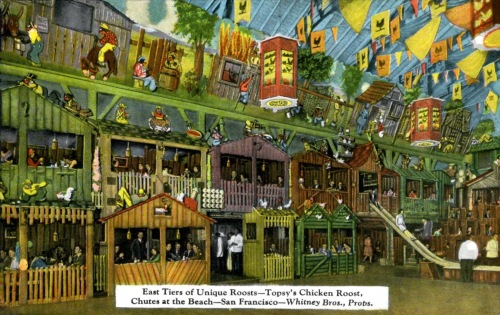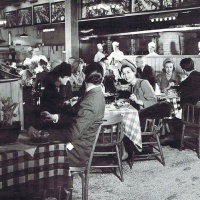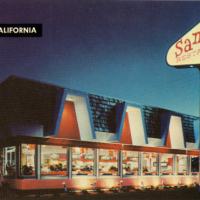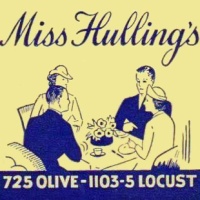 Not that they found American restaurants especially funny.
Not that they found American restaurants especially funny.
Au contraire. On their car trip across the continent in 1935/1936 writers Ilya Ilf and Eugene Petrov, billed as “Soviet Mark Twains,” observed what they regarded a nation of joyless folks who ate tasteless food in restaurants designed for speed and efficiency. As they put it, “The process of eating was just as superbly rationalized as the production of automobiles or of typewriters.”
The acme of rationalization in their opinion was the Automat where a wall of metal and glass boxes filled with sandwiches and pie separated customers from staff. They preferred the Childs restaurant chain with table service. “At Childs one receives the same clean handsome food as in a cafeteria or an automat. Only there one is not deprived of the small satisfaction of looking at a menu, saying, ‘H’m,’ asking the waitress whether the veal is good, and receiving the answer: ‘Yes, sir!’”
They did not visit luxury restaurants, preferring commonplace eateries where average Americans ate, such as cafeterias, drug store lunch counters, and roadside “dine & dance” halls. They also went to a football game, an Indian reservation, and other quintessentially American sites and events that they described in a book published in the Soviet Union, and then translated for Americans as Little Golden America (Farrar & Rinehart, 1937).
In Chapter 4 (Appetite Departs While Eating) they asked, “How does it happen that the richest country in the world, a country of grain growers and cattle raisers, of gold and remarkable industry, a country which has sufficient resources to create a paradise, cannot give the people tasty bread, fresh meat, real butter, and ripe tomatoes?” Not surprisingly, as dedicated socialists they located the cause of the problem in capitalism which reaped higher profits in shipping frozen beef and unripened California tomatoes cross country than in local food production.
By contrast, they cited Soviet Commissar of Food Anastos Mikoyan who was at that time spearheading a Stalinist reform campaign of joyous eating and champagne for everyone to replace the habitual diet of cabbage soup and mush. Mikoyan’s office produced a landmark cookbook with color photos of cosmopolitan meals (The Book of Tasty and Healthy Food, 1939). Sitting in an American cafeteria in 1935, Ilf and Petrov felt that a Mikoyan speech that declared food in a socialist country must bring joy to its eaters “sounded like poetry to us.” But the truth was that Soviet leaders, Mikoyan included, were admirers of the U.S. rationalized system of production, including its food.
During their American travels Ilf and Petrov learned to drink tomato juice – well-peppered to their taste — as an appetizer, but could not adjust to eating melon before dinner, despite its “place of honor among American hors d’oeuvres.”
They frequently made fun of drugstore meals that were numbered #1, #2, etc., and whose prices were based solely on quantity. “If in Dinner #2 a course called ‘country sausage’ consists of three chopped off sausages, then in Dinner #4 there will be six chopped off sausages, but the taste will be exactly the same.” When they ate at Bernstein’s fish restaurant in San Francisco, they were happy that the dinner there made up for that day’s drugstore lunch #3.
Seriously, why did they keep eating in drug stores, especially in a city of restaurants such as San Francisco? They could have tried Chinese food, or gone to a tea room or any number of places.
In my opinion they hit bottom when they visited a palace of fun outside San Francisco known as Topsy’s Roost, a “dine and dance” joint whose corny racist theme was based on shacks, pickaninnies, and fried chicken. Were their Soviet readers envious when they read, “For fifty cents [a man of moderate means] gets a portion of chicken, and, having eaten it, dances until he is on the verge of collapsing. After he is tired of dancing, he and his girl . . . ride down a polished wooden chute placed in the hall especially for entertainment-seeking chicken eaters.”
The book was said to be popular in Russia. I’d love to know what readers thought about America after reading it.
© Jan Whitaker, 2015

































 It's great to hear from readers and I take time to answer queries. I can't always find what you are looking for, but I do appreciate getting thank yous no matter what the outcome.
It's great to hear from readers and I take time to answer queries. I can't always find what you are looking for, but I do appreciate getting thank yous no matter what the outcome.


